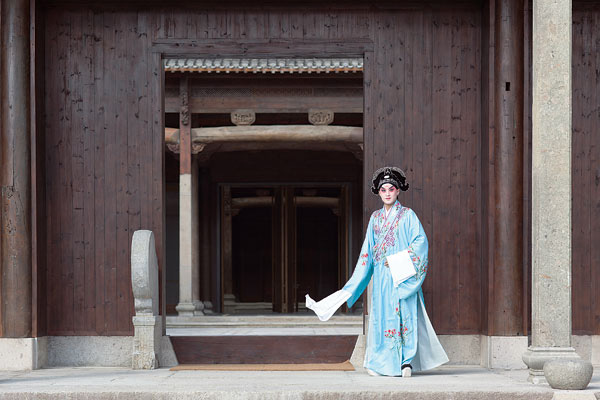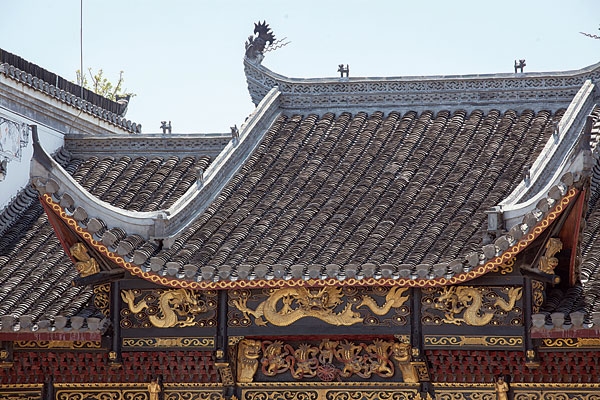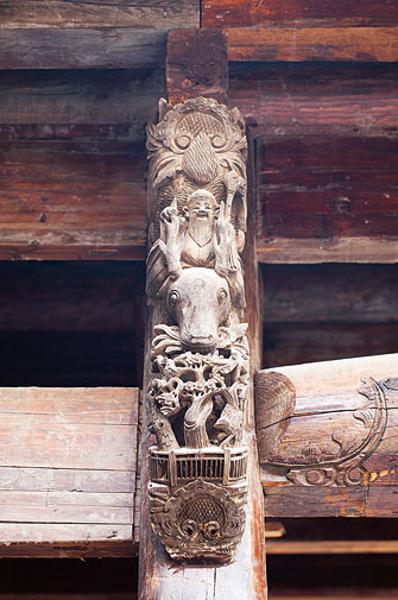
Buying and restoring ancient houses has become a hobby of China’s mega-rich.[Photo provided to Shanghai Star]
There is more than one housing market booming in China. Wealthy collectors are buying up ancient houses and restoring them to their former glory. Xu Jinqian visits a recently re-built compound in Zhujiajiao where everything old is new again.
In a 600-year-old wu-fenglou, a large house known as the “mansion of five phoenixes” in Mandarin, a 21-string Chinese zither is being played as people wander around the ancient building admiring its brilliant restoration.
In another part of the spacious compound, hundreds of people gather before a younger, century-old Chinese traditional opera stage to watch an abridged version of a 1598 Kunqu opera, Peony Pavilion.
All this is being staged to celebrate the completion of the renovation of the ancient Ahn Luh Zhujiajiao compound in Zhujiajiao, the best known water town in Shanghai. The jewel in the crown of the renovation is the wufenglou, which has been lovingly restored to its original state, in a manner that its collector and owner Qin Tongqian says “best matches the quaint flair of the mansion”.
The 14,000-square-meter and 10-meter-high mansion, that has upturned eaves resembling the spreading wings of five pairs of phoenixes, is just a drop in the bucket, or “a hair off a bull’s back”, as the Chinese saying goes, in Qin’s staggering collection. He is a self-described “antique house collecting maniac”.
Like a growing number of businessmen-turned-collectors who have developed an interest in ancient houses, Qin is taking the initiative to put his collections to daily use.

The wufenglou, the mansion of five phoenixes, boasts a history of 600 years and was recently renovated.[Photo provided to Shanghai Star]
Standing on a corner of the 1,700-year-old water town, Ahn Luh Zhujiajiao, with the wufenglou as its centerpiece, is possibly the first “all-old hotel” in the country, with most building materials, from pillars to tiles to beams to a corbel, reused from Qin’s warehouses and dating back to the early 1900s.
Thirty-five independent villas made from the materials are expected to open to the public early next year, charging up to $1,000 a night for anyone who may want to sleep on a meticulously carved yellow rosewood bed that is believed to have been made in the Qing Dynasty (1644-1911).
“It’s an example showing the possibilities of leading a modern lifestyle in an ancient living environment,” said Ruan Yisan, professor of urban planning at Shanghai’s Tongji University and an ardent advocate of historic-building protection, at the celebration ceremony last month.
According to Ruan, renovating and rebuilding these old houses anywhere other than the place they were originally built, actually violates the principles of protection and preservation of antique buildings, which require the “five originals”: the original materials, craftsmanship, structure, style and environment.
Still, this is the second best option when there is no other solution, Qin says.

The wufenglou, the mansion of five phoenixes, boasts a history of 600 years and was recently renovated.[Photo provided to Shanghai Star]
An oft quoted statistic provided by Feng Jicai, chairman of the Chinese Folk Literature and Art Society states that 300 villages are dying everyday in China because of urbanization. A total of 900,000 villages were destroyed over the past decade, the majority of which were ancient villages.
Ancient villages are widely classified as one or a cluster of hamlets that boast a minimum of 10 Chinese typical residences, temples of other types of architecture, and were naturally formed before 1911.
For many years, a lack of money has been the most common excuse used by local administrations, especially township governments, for the mishandling of antique houses.
Zhang Zhu’an is a trader who created a market and consequently, made a windfall, from the expensive hobby of collectors of ancient houses.
The former carpenter from Dongyang, Zhejiang province, where the largest quantity and highest quality of rosewood furniture in China is made, spotted the trend of antique house collecting about 10 years ago and established a business based upon it.

The wufenglou, the mansion of five phoenixes, boasts a history of 600 years and was recently renovated.[Photo provided to Shanghai Star]
On an open, almost deserted stretch of land in his hometown, Zhang, 64, together with a team of “dab hands”, has been rebuilding houses with numbered bricks, wood panels and pillars. It usually takes at least three to four months for the team of 10 craftsmen to patch up the houses, which, when they arrive, are as scattered as “a biscuit falling from six-floor-high apartment building”, as Zhang says.
Middlemen like Zhang will charge 10 to 30 percent of the sale price of the house to reassemble the structure. The house is then shipped from the remote construction site that has neither name nor address, to the gardens of the country’s richest people.
“It’s undeniable that we are making a living from them, but there is nothing wrong with it,” says Zhang, in response to criticism that the houses lose their roots when they are dismantled and shipped around.
“What we are doing now is definitely better than leaving them suffering from harsh weather and daily wear,” he added.
In 2012, the government of Suzhou, Jiangsu province, introduced a series of new regulations regarding the protection of old houses and villages, allowing private capital to be invested in local historically important sites.

The wufenglou, the mansion of five phoenixes, boasts a history of 600 years and was recently renovated.[Photo provided to Shanghai Star]
Prior to that, there were no policies either allowing or disallowing the sale and resale of antique houses, as long as they were not listed by the local or central government as “relics under protection”, leaving tens of thousands of collectors “as if playing games in the dark”, as Yu Feng, vice-chairman of Collection Association of Club in Yiwu, Zhejiang province, put it.
The logistics magnate from the city home to the world’s largest trading center of small commodities such as zips and socks, called antique houses “the ultimate item for any Chinese collector”, as they make the perfect home for antique porcelain, furniture and paintings.
But others argue that the thriving house-collecting market is actually hastening the death of these antique houses, as the original residents, usually people who get by with just enough food and clothing, are more than ready to exchange their houses for cash.
“They barely live inside (the antique houses), they cannot even spend a whole day there. Practicality is never a concern. What pushes up the price is always legendary stuff: the type of people who used to reside there, or the propitious meaning of a certain carving,” says Zhang.

A part of the wufenglou.[Photo provided to Shanghai Star]
